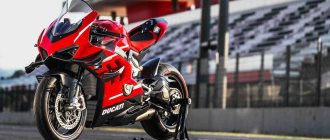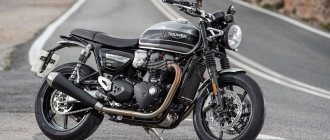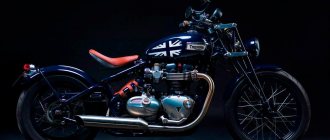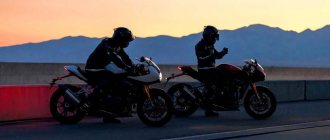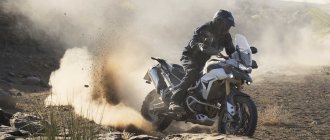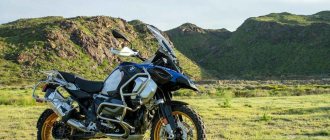When Triumph introduced the Daytona 675, the model became popular for a number of reasons, but primarily because it was unusual. Most of its classmates were equipped with four-cylinder engines with a displacement of 599 cc, but Triumph removed one cylinder and pumped the remaining ones to 675 cc. This bike had a unique exhaust sound, was narrow, handled great, and rode very well.
Most likely, most fans value it precisely for its sound, but at the time when this model came out, racing in the supersport class was extremely popular. The model raced with varying degrees of success, but despite this, the Daytona gained truly cult status.
That's why the news from Triumph at the end of 2022 that they were planning a 765cc three-cylinder engine for the Moto2 class in the coming year, replacing the 599cc four based on the Honda CBR600RR, seemed extremely interesting to many fans (details here ). Actually, this meant the release of the Triumph Daytona Moto2 765 2020 soon.
Yes, but not so.
Triumph simply remained silent on the Daytona update, instead releasing the updated Street Triple 765, which, while fun, was not a Daytona. The big news was with this version, the Daytona Moto2 765, created in collaboration with Dorna to strengthen ties in Moto2. This is a low-volume model with a series of 1530 copies - 765, i.e. half of them went to North America, and the rest will be sold in Europe.
Triumph Daytona Moto2 765
The imagination, of course, painted the most amazing pictures of what the new Daytona would be like. There weren't many questions about the 765cc three, but what about the connection with Moto2? New frame, swingarm? Big brakes? Advanced electronics? A common thing for new models... but this is where things started to get weird.
Engine
Let's go through the good parts of the Triumph Daytona Moto2 765, starting with the engine. 765 cubes is a cubic capacity that is optimal from many points of view, in which, in particular, the Suzuki GSX-R750 shines. The Triumph inline three is short-stroke, with a cylinder diameter of 78 mm, a piston stroke of 53.38 mm, four valves per cylinder, two overhead camshafts, a compression ratio of 12.9:1. According to the manufacturer, this is the most powerful version of the new three, producing 128 horses and 80 Nm from the crankshaft.
Triumph Daytona Moto2 765 engine
Chassis
Next, the Triumph Daytona is equipped with Ohlins suspension - a NIX30 fork and a TTX36 monoshock, both of course fully adjustable. The brakes are the latest generation of Brembo Stylema, with an additional ventilation duct that provides significant airflow to the pads to prevent overheating. Steel-reinforced lines transmit power from yet another piece of Brembo engineering: the 19/21 MCS master cylinder. Adjustable lever proportion allows you to fine-tune the feedback and response of the braking system to suit the rider's wishes.
Well, the list of features of the small-scale model is completed by the Shift-Assist quickshifter, which works in both directions, Pirelli Supercorsa SP tires in the stock configuration, and a full-color LCD instrument panel with a multifunction joystick, already known from some of the brand’s new products.
The new motorcycle is lighter than its predecessor thanks to a carbon body kit, a single seat (there is no passenger equipment at all) and the transition to e-gas - a first for the Daytona line. Triumph claims a dry weight of 164kg, which is of no interest to anyone because they don't ride dry bikes.
And all this is good, but here’s what’s strange: the motorcycle is built on an old frame and swingarm, only with an anodized coating. Not that this is a bad thing, but for a new model, especially with an engine 13% larger than the previous one, am I the only one who thinks Triumph didn't do much?
Triumph Daytona track test
But stop whining, it's time to roll.
Given the connection with Moto2, it was only natural to bring the Triumph Daytona 765 straight to the track. The stock tires were swapped out for Metzeler Racetec TD slicks and after one lap they were ready to burn.
Anyone familiar with the previous Daytona 675 will find the new 765 familiar. The ergonomics aren't too different, and the slim silhouette remains largely unchanged.
The main difference is the more powerful engine, of course. Not striking, but noticeable - as if someone spent a lot of money, time and effort on modifying the stock 675 engine to the latest tuning trends, as is the case with sportbikes. The improvements are noticeable on all fronts and at all speeds, especially in the low and mid-range when you straighten the bike and exit a turn. The top is also richer than that of its smaller ancestor, but not to say that in any significant way. I expected longer passes, but in fact I just quickly reached the cutoff.
This, in turn, brings us to a close acquaintance with the Triumph Shift Assist (TSA) quickshifter - we have to communicate with it often. Perhaps the liter sportbikes made me a little lazy, but I was almost tired of switching to the 765. Upshifting at full throttle was especially fun when exiting a widening right-hander where you had to accelerate while still hanging to the right. Thanks to the quickshifter, you don’t have to jerk the gas while hanging in an awkward position; you just need to lift your foot with your toe - however, while loading your outer leg. This is where a return box would be very useful, but that's a separate conversation.
Perhaps this only applies to our Triumph Daytona, or some additional calibration is needed, but at high speed the quickshifter began to go wrong, both up and down - so much so that we had to return to the usual shifting style, with a slight surge of gas when shifting up and with the clutch - down. I’m far from saying that there’s something wrong with the quickshifter on this model; most likely it’s due to some kind of adjustment on our test unit. The mileage on it is just over 800 km, and perhaps it’s just time for the first maintenance with tightening and adjustment.
The otherwise graceful Triumph Daytona, with its sharp 23.2-degree head angle and short 91mm trail, is a very nimble and well-handling bike. She steers quickly and confidently, even when braking. Some may value the stability of a longer trail, but I personally really like the nimble nature of the Daytona - so much so that I can completely understand why Triumph decided to keep the old frame and swingarm: if it's not broke, don't fix it.
It’s easy to guess that Ohlins suspensions on the track fully satisfy the most demanding tastes - smoothing out bumps and feedback are exactly what you would expect from components of the venerable Swedish brand. I especially liked the TTX rear shock because the rebound and compression smoothing is adjusted using two adjusters that are easy to use even with gloves.
Brembo Stylema calipers
Sounds really nice so far, doesn't it? But there were still questions for Triumph: at first I was wondering why they left the old frame and swingarm, but then I became convinced that this was a good solution. And now the second question has arisen: why install top-end Brembo Stylema calipers with an MCS master cylinder on 310 discs?
Most regular riders won't have any problems with this kit, as the master cylinder and calipers have impressive braking power, sensitivity and modulation. But for those who actually take a Triumph Daytona 765 for the track, small discs (on a Yamaha R6, for example, 320 discs, and this is far from the standard) will be subject to overheating, and the brakes will float. Maybe I'm worrying too much about this, and perhaps serious athletes will correct this flaw first? Don't know.
But that’s not all. Questions about electronics - in particular, ABS and traction control. First, a little positive: the full-color LCD instrument panel is easy to read, and the menu layout is easy to navigate ; you just need to get used to the buttons and joystick a little.
And then something strange begins: ABS is always on, and suddenly it’s not as bad as it might seem. In Track mode (one of five, along with Road, Rain, Sport and User), the ABS response threshold is chosen very well, and it hardly interferes during normal driving. But the inability to reduce its interference or turn it off completely is unacceptable for a sports motorcycle. Euro5 is probably to blame for this - but it concerns road driving.
And the traction control is just annoying. It has different levels of intervention depending on the riding mode, but it can't be adjusted, although it can be turned off. And unlike ABS, the thoughtfulness of the algorithms of which was a pleasant surprise, traction control works crudely and awkwardly: even in Track mode, I noticed the light of the traction control signal, and I am absolutely sure that at that moment I did not need it - for example , at the exit of the turn, on the thick part of the sidewall, accelerating. I'm willing to allow a little slip to get the bike on track, and on fresh, warm slicks, a millisecond loss of grip is nothing.
Today I will tell you about a motorcycle with a twist! Latest generation Triumph Daytona 955i. The hero motorcycle in the film Torque (2004), the leader of a gang of biker bandits rode on it, and I’ll tell you for a reason))
The Triumph Daytona 955i was produced between 1997 and 2006 at the Hinckley, England factory. Originally called the Daytona T595, the first 955i appeared in 1999. I have the latest generation 955 sport from Triumph, now, unfortunately, Triumph does not make liter sports, although many people would like it. Why is the liter motorcycle called T595, you ask? This is because the new liter engine was called T5, and the volume was 955 cubic centimeters. Later the guys realized that this was causing confusion and renamed it 955i.
First generation:
Second generation:
Third generation:
The first generation had problems, low power and the weight was a little more than the Japanese, which greatly limited the potential of the chassis. By the second generation, they removed all the problems, increased power and reduced weight, and the third generation turned out to be absolutely perfect, they eliminated the shortcomings of the second generation, increased power and reduced weight, after which the third generation began to compete well with the Japanese and Italians. In fact, the second generation is very different from the first, and it is the 2nd and 3rd generations that I would recommend taking, they are more comfortable and the chassis with the engine is modernized.
The frame was developed jointly with the famous Harris Performance, the fuel-injected 3-cylinder engine was made at Lotus, not a spendthrift, but a legend!) The design attracts with its polish, which is why the motorcycle constantly attracts attention. The single-sided aluminum cantilever swingarm is not only lighter than a conventional double-sided one, but also much stiffer, which has a very good effect on handling. Tires: Front: 120/70 ZR 17, rear: 190/50 ZR 17. The motorcycle is very easy to handle, moving it from side to side is a pleasure, for which many thanks to Harris for his frame!)
We all know that in-line fours have no bottom end and need to be revved, but the V2, on the contrary, has a juicy bottom end and runs out of steam at high revs. The inline three has sharp acceleration, maximum torque and power in almost the entire rev range, it really pulls in any gear and at any speed)
Adjustable Showa suspension front and rear allows you to customize your horse completely to suit you. Controlled by the power of thought, often laid it to victory) The brakes are 4-piston 320 Nissin brakes in the front and 2-piston 220 Nissin brakes in the rear. The brakes are clear and easily controlled; out of habit, I use two brakes at once. Box with 6 gears. A 21-liter tank lasts a long time, the average consumption surprised me very much, from 7 to 9 liters, and when I was driving along the 200-230 highway it consumed an average of 7.4 liters) of power of 150 hp. quite enough, with a weight of 185 kg, acceleration is on par with other liters, for example, with a Yamaha R1 of the same 2004, we constantly rode the same way, although it has 170 mares. I accelerated to a maximum of 280 km/h, it will go faster, because... There is a supply, but I haven't tried it again.
The comfort of this motorcycle is a separate issue! The landing is considered the most comfortable among all sports, this was a special trump card from the Triumph company. The silushki are made very correctly and comfortably, and the material itself and softness will amaze and surprise any biker. There were cases when girls who rode number two sat with me at Daytona and then did not want to get off it and change to other motorcycles, because... it's really very comfortable to sit)
The designers have tried very hard and, in my opinion, the latest generation looks very fresh and harmonious. This motorcycle always attracts attention, people are constantly photographed next to it, and the motorcycle brothers always look at it and ask about such an interesting motorcycle. Not only is it beautiful and stands out among many motorcycles, it immediately attracts the eyes of all passers-by and motorcyclists with the sound of the engine)) Its sound is unlike anything else) Three cylinders are pleasing to the ear and give excellent notes of exclusivity. With this motorcycle, the pilot is always guaranteed to be attentive and stand out from the crowd, which is what really attracts me to it!)
Regarding reliability: Everything worked like clockwork for me, I did maintenance on time and that’s it. The first models had sores and illnesses that were sometimes annoying. People really praise the latest generations for reliability and I completely agree with them. As for spare parts, the dealer has everything, same Mr. Moto, or you can order from Europe or E-bay, everything arrives within a week or two.
For tuning lovers there are a lot of different tuners! I installed a lot of carbon fiber, damper, handles, high glass, exhaust, K&N zero, hager, bi-xenon, diode turn signals and pumped a lot of nitrogen into the tires) If you want, you can flash your own brains for different exhausts, tune the engine the way you want, it’s done This is done using the TuneECU program and an electronic device K-line adapter.
And now a photo of my handsome man! It was me who rode at Moscow Raceway at RTCC.
A few photos with my loved ones))
Please don't blame me for not having any equipment, etc. I'm working on it, and when I ride with my girlfriend, I ride like a pensioner.
And in this photo, the girl’s dress has risen up from the sight of the Daytona)) By the way, in the photo is Vovan Biker, our famous motardist)
Children also approve of Daytona))
Collected flies 400 km away)
A little porn)
I also rode drag, won all the races except the one where I slept halfway through the start of the track) By the way, I also rode with Pete))
On the embankment:
But such a set is good to have in the garage!
At the end I’ll add a little video with my horse:
I often get caught here)
Triumph Daytona Moto2 765 On the road
Triumph Daytona Moto2 765 On the road
After all the criticism it received on the track, the Daytona 765 is justified by being a great performer on the road. And although I'm not a fan of sportbikes as road users, I have to admit: there are a lot of sports models that are much worse as everyday transport.
Sporty ergonomics aren't the best choice for casual riding, which is why naked bikes exist—in this case, the Street Triple 765. On the other hand, it's hard to deny that sportbikes, including the Daytona 765, are beautiful things to look at.
If you’re going to ride a sportbike on the road, the Triumph Daytona 765 would be far from the worst choice: the clip-ons are not too low (by the standards of sportbikes), the knees are not too bent, the tank volume of 17 liters allows you to travel a good distance between gas stations (if you really want to).
Given the 765's improved low-end and mid-range performance, the Triumph Daytona Moto2 765 is very capable on the road. There is simply no need to rev it up to the top and the cut-off during normal driving, and, given the high-torque power of the engine, you don’t have to change gears too often on the roads - at least, not as often as on the track. The lower speed also alleviates the problem of a glitchy quickshifter.
And on picturesque winding roads, the renowned chassis rewards with nimble and precise steering , although the track suspensions may seem a little harsh for ordinary roads. Adjustment generally solves the problem, if you don’t take into account the inconvenient spring preload adjuster.
And there are more than enough brakes when driving on the road : you probably won’t be able to overheat them. Five driving modes allow you to choose the character of the engine to your liking, but I somehow got by with only Road mode: the traction is smooth and controlled, and the electronic nannies didn’t even seem to interfere during my rides. Once again: a more reasonable choice if road driving is a priority would be the Street Triple, which is slightly less powerful, but more convenient and resourceful. The reality is that the Street Triple is a much cooler all-round motorcycle, and the Daytona is extreme and adrenaline-fueled.
Triumph Daytona Moto2 765
Exclusive
Triumph Daytona Moto2 765 2022 is a limited edition motorcycle. It looks great and gives access to a very small club of owners, but for 1,800,000 rubles. in its most basic form, you can buy a lot of other things, including fierce liter sports and very distinct motorcycles of any of the popular classes and brands.
Otherwise, this is a very good bike that would actually be worth producing in larger numbers, even if it meant using cheaper components for a lower price. And just as I love and respect the Suzuki GSX-R750 for its unique position in the world of sportbikes, the Daytona 765 is beautiful in its severe under-literity - it will have fun, but most likely will not kill you.
In conclusion, I expected more from the Daytona Moto2 765, co-branded with Dorna and clearly intended for racing - for example, a radical new mid-sized sportsbike with headlights. Instead, I saw a warmed-up, slightly pumped-up version of the previous model, which would have been quite good without this aura of exclusivity.
If you don't expect too much from it - just consider it an update to the Daytona 675 and not a Moto2 projectile - it's quite good.
Classmates
Kawasaki Ninja ZX-6RWorking volume - 636 cubic meters. cm Maximum power - 125 hp. Maximum torque - 67 Nm Dry weight - 161 kg Suzuki GSX-R600Working volume - 599 cubic meters. cm Maximum power - 117 hp. Maximum torque - 66 Nm Dry weight - 163 kg | Yamaha YZF-R6Working volume - 600 cubic meters. cm Maximum power - 123 hp. Maximum torque - 68 Nm Dry weight - 162 kg Honda CBR600RRWorking volume - 599 cubic meters. cm Maximum power - 117 hp. Maximum torque - 66 Nm Dry weight - 155 kg |
Specifications
Motorbike
| brand, model | Triumph Daytona |
| Version | 600 |
| Type | sportbike |
| Year of issue | 2004 |
Engine
| Type | petrol in-line 4-stroke |
| Supply system | fuel injection |
| Cooling system | liquid |
| Number of cylinders | 4 |
| Working volume, cm cubic. | 599 |
| Maximum power, hp (kW)/rpm | 110 (80.3)/12 750 |
| Maximum torque, Nm/rpm | 68/11 000 |
Transmission
| Transmission | manual 6-speed |
Brakes
| System | hydraulic |
| Front | 308 mm |
| Rear | 220 mm |
Tires
| Front | 120/70 ZR17 |
| Rear | 180/55 ZR17 |

